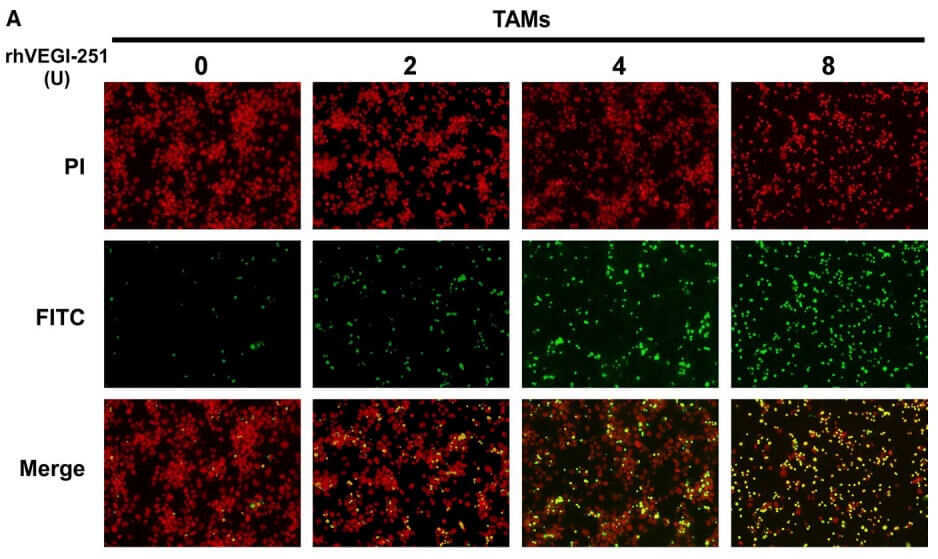Hi-Affi™ Humanized VEGI Immune Checkpoint Knockin Mouse Model
Dysfunctional or exhausted T cells usually arise in chronic diseases such as chronic viral infections and cancer and express high levels of co-inhibitory receptors. Therapeutic blockade of these receptors has considerable clinical efficacy in the treatment of cancer. With the development of immunotherapies, immune checkpoint blockade therapies have been shown to be of substantial clinical benefit in cancer patients. Creative Biolabs has successfully established a serious of Hi-Affi™ “humanized” animal models and can provide specialty humanized VEGI immune checkpoint knock-in mice for our clients all over the world.
VEGI Immune Checkpoint Pathway
Vascular endothelial growth inhibitor (VEGI), also known as TNF-like ligand 1A (TL1A) and TNF superfamily member 15 (TNFSF15), is an anti-angiogenic protein which is coded by the TNFSF15 gene. It has a carboxyl-terminal which is present on the exterior of the cell surface, as well as a transmembrane domain and a short cytoplasmic tail. VEGI is one of the tumor necrosis factor (ligand) superfamily, where it is member 15; its ligand is TNFRSF25, which is also known as death receptor 3 (DR3) and is a newly recognized immune-activating receptor. VEGI is the sole known ligand for death receptor 3, and it can also be recognized by decoy receptor 3. VEGI induces apoptosis specifically on endothelial cells and has been demonstrated to be an inhibitor of tumor angiogenesis in animal models. Like other death ligands, VEGI activates both the NF-kB and apoptotic pathways in the target cells.
 Fig. 1 rhVEGI‐251 triggers marked apoptosis of Tumor‐associated macrophages (TAMs). 1
Fig. 1 rhVEGI‐251 triggers marked apoptosis of Tumor‐associated macrophages (TAMs). 1
Function of the VEGI Signaling Pathway
VEGI functions as an angiogenesis inhibitor by inhibiting the endothelial cell proliferation. And it has been shown that expression of VEGI on mouse tumor cells triggers elimination of the tumor by CD8+ T cells and induces T cell memory such that mice are resistant to subsequent tumor challenge. VEGI is able to activate the transcription factor κB (nuclear factor-κβ). It induces the degradation of the inhibitory subunit IκΒα and helps in the nuclear translocation of the p65 subunit of NF-κβ. TNFSF15 also activates c-Jun N-terminal kinase and inhibits the growth of various human tumor cell.
Development of Humanized VEGI Immune Checkpoint Knock-In Mice
Checkpoint blockade is an immunotherapy approach to block the ability of certain proteins, called immune checkpoint proteins, which limit the strength and duration of immune responses. It has been clearly shown that tumors can make use of certain checkpoint pathways to resist T cell immunity. In recent years, checkpoint blockade therapies have led to significant clinical advances, resulting in durable clinical responses and long-term remission in a fraction of treated patients. With advanced technology and years of experience, Creative Biolabs has successfully launched an array of well-characterized Hi-Affi™ “humanized” animal models, which can provide you with humanized immune checkpoint knock-in mouse models including humanized VEGI knock-in mouse. Our scientists are willing to assist you in your studies of anti-tumor immunotherapies. Please feel free to contact us for more detailed information.
Creative Biolabs also offers other various Humanized Mouse Models you may be interested in:
Reference
-
Dong, Xinhuai, et al. "Tumour‐associated macrophages as a novel target of VEGI‐251 in cancer therapy." Journal of Cellular and Molecular Medicine 24.14 (2020): 7884-7895. Distributed under Open Access license CC BY 4.0. The image was modified by extracting and using A part of the original image.
For Research Use Only.
